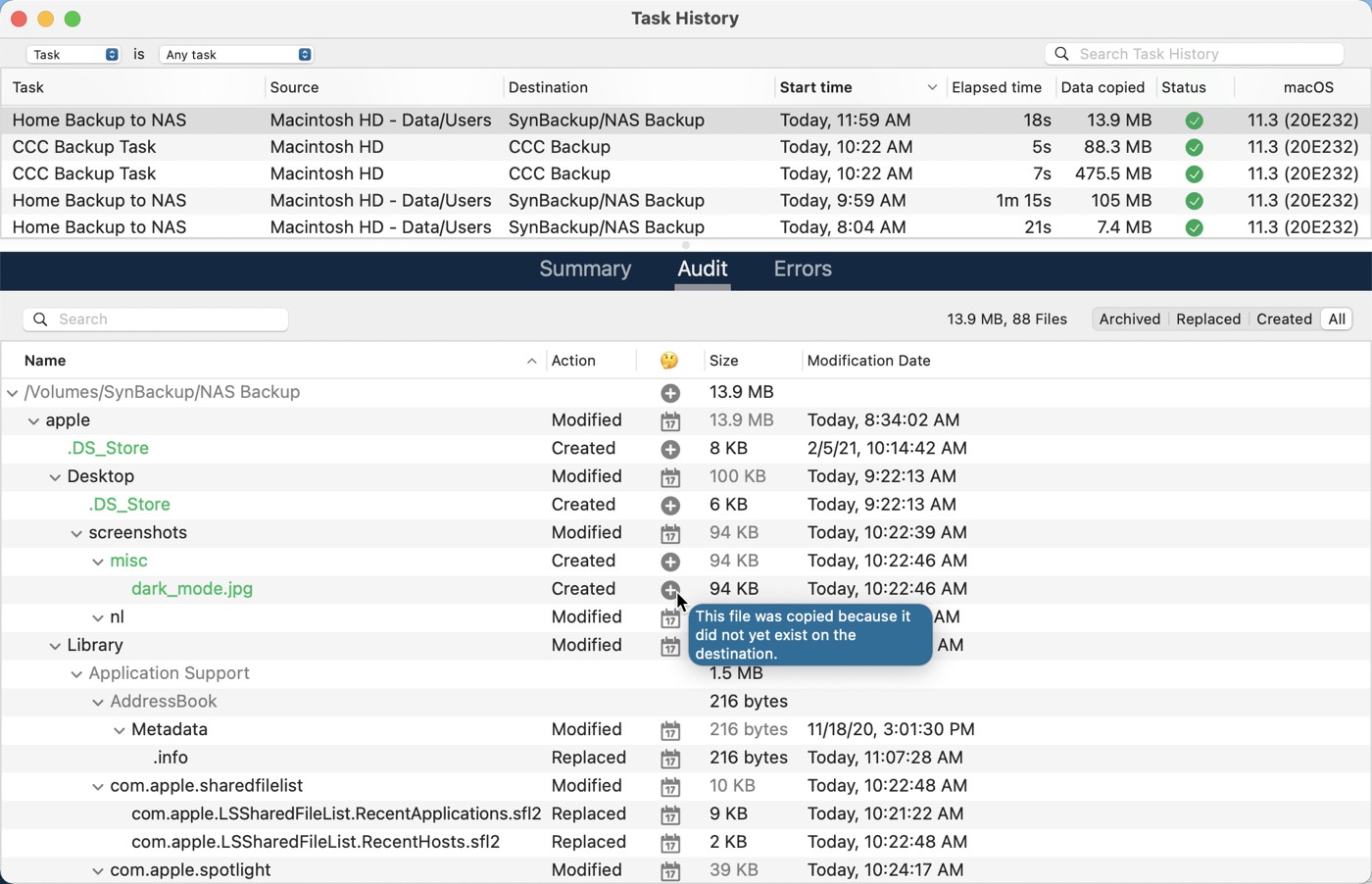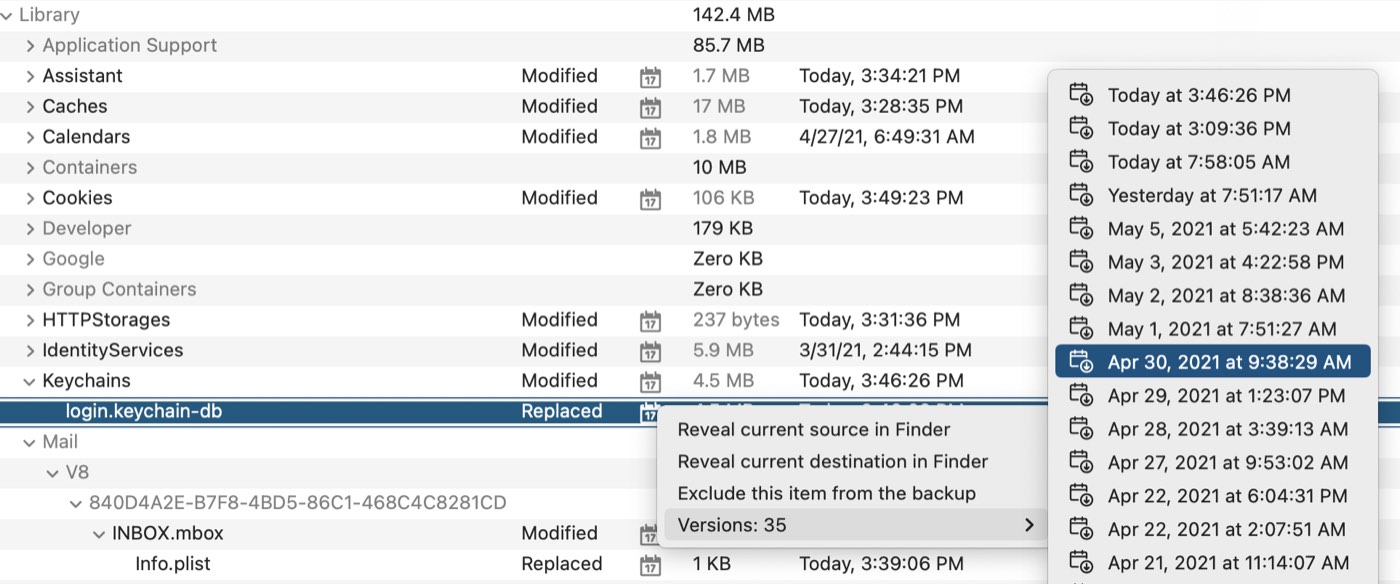Each time CCC performs a backup or restore task, the results and statistics of that task are recorded and displayed in CCC's Task History window. To view task history, click on the Task History button in the toolbar, or choose Task History from the Window menu.

Task events can be filtered and sorted by task name, source, destination, start time, or status. CCC will show up to 2000 task history events. Each event will indicate when the task started, how long it took, how much data was copied, the overall status of the task, and the CCC and macOS version at the time of the event. There are additional columns available that are hidden by default (e.g. CCC version, Total Size, Settings); right-click on the table header row to choose which columns should be visible.
The color of the status indicator is defined as follows:
 Green: Task completed successfully
Green: Task completed successfully Yellow: The task was completed, but errors occurred while transferring some files
Yellow: The task was completed, but errors occurred while transferring some files Red: An error occurred that prevented the task from completing
Red: An error occurred that prevented the task from completing Gray: The task was canceled
Gray: The task was canceled
Audit: Viewing details about the modifications made by the backup task
When enabled for a particular task, CCC will record detailed information about the transactions that occurred during the task, e.g. files copied, files updated, folders created or updated, files deleted or archived. Each transaction will indicate the size and modification date of the file at the time of the backup, and the action that was applied to the item. A status icon in the "🤔" column indicates why the action was taken, e.g. a file may have been updated because its size or modification date differed on the source and destination. You can hover your mouse over this icon for detailed information about the differences that were noted for that particular item.
Actions applied to files and folders
- Created: (Folders only) This folder was created on the destination because it did not yet exist.
- Modified: (Folders only) The attributes of the folder were modified on the destination (e.g. creation date, permissions, owners).
- Replaced: (Files only) The file was replaced because the size, modification date, or checksum differed.
- Updated: (Files only) The file's content was not changed, but the attributes of the file were updated (e.g. creation date, permissions, owners).
- Cloned: (Files only) The file was not copied, rather it was created via the clonefile feature of the APFS filesystem (only applicable when the source and destination are folders on the same APFS volume).
- Deleted: The file or folder was deleted (note that if snapshot support is enabled on the destination, the item may still be retained by a snapshot).
- Archived: The file or folder was moved into the "_CCC SafetyNet" folder.
- Indexed: The file was not recopied, but CCC read the entire source file and calculated a checksum of this file for future reference.
Viewing the current item on the source or destination, viewing older versions
Right-click on a transaction to view a contextual menu of options specific to that item. If older versions of a file are available in a snapshot, those versions will be listed in the Versions sub menu. Note that these options will be disabled if your source and destination volumes are not mounted.

CCC will prompt to remove a task's audit when you change the source or destination
Transactions stored within a task's audit are specific to the source and destination that were selected when the task ran. When you change the source or destination to a task, CCC will prompt you to either remove the current audit records or to create a new task. Removing the audit records won't affect any of the data on your source or destination, it only removes the record of changes that were made to the destination in the past. When you remove audit records, you'll no longer be able to see the transactions in the Task History window > Audit tab, and you won't be able to verify the integrity of files on the source or destination against the "last known state".
If you no longer need a record of the changes made to the destination in the past, or if you've erased the destination, then we recommend that you remove the audit records.
If you're configuring a new source:destination pair, however, we recommend that you create a new task for that purpose. Ideally, you should retain a separate task for each source:destination pair that you have so you can avoid making constant changes to the source and destination configuration.
Related documentation
Errors
There are many hardware and filesystem problems that could affect your Mac's hard drives. Filesystem and media corruption are commonplace, and CCC delivers expert advice to you when errors occur. CCC's Task History window shows the results of all of your backup tasks, and details of any errors that occur. CCC enumerates these errors, analyzes them for common conditions, then explains the problem in simple terms with down-to-earth advice for fixing the problem.

Exporting a list of affected files
If you would like to save a list of the affected files in the errors table, select the affected items (or press Command+A to Select All), then choose Copy from CCC's Edit menu (or Command+C) to copy the list of items to the clipboard. Please note that every error may not be the same. When you export a list of files, the per-file contextual information is not retained. Return to CCC's Task History window for the contextual information and advice specific to each file.
Getting help for common errors
When errors occur, CCC will categorize the error and offer troubleshooting advice. For some errors, CCC will offer helpful buttons at the bottom of the task history window that will, for example, take you to Disk Utility or reveal a corrupted file in the Finder. If the affected file is one that doesn't need to backed up, click the button to exclude the item from the backup task to avoid future errors on that file. Click on each error to see what CCC recommends to resolve the error. If you're stuck or overwhelmed, or if CCC's advice alone isn't helping you resolve the problem, click the "Help Me!" button to submit a summary of the problem to the Bombich Software Help Desk.
Related Documentation
Task Trends Dashboard
To view task-specific statistics over time, right-click on a task event and choose Show Task Trends Dashboard. You can view the task trends based on elapsed time, total source data set size, the number of files copied, the amount of data copied, or the size of the largest file. Hover your mouse over the chart to see the details of each event. Click on an event to reveal that event in the Task History window.

Can I remove events from CCC's Task History window?
To remove one or more task events from the history table, select the events, then right-click on the selection and choose Remove from the contextual menu. Removing task events from the Task History window has no effect on the backup, it only removes the event from CCC's Task History window, as well as any transactions stored in CCC's task history database. You must be logged in as an administrator user to delete task history events.
If you would like to clear all of CCC's task history, open the Task History window, then choose Clear Task History... from CCC's Task menu.